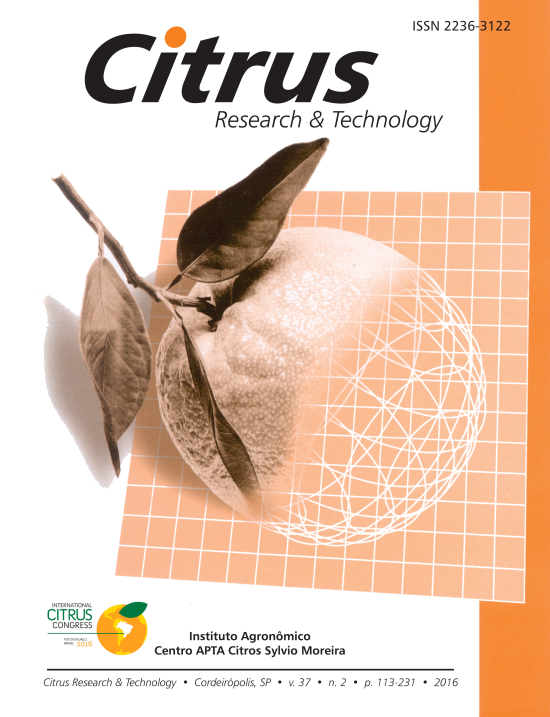Recipientes e métodos de enxertia na produção de mudas de citros com porta-enxertos duplos
Containers and grafting methods for the production of citrus nursery trees on le-rootstocksdoub
Daves Willian Setin & Sérgio Alves de Carvalho
Resumo
A morte súbita dos citros - MSC, doença de agente causal indeterminado, tem provocado a substituição do porta-enxerto limoeiro Cravo por variedades tolerantes como citrumeleiro Swingle, que, entretanto, apresenta menor resistência à deficiência hídrica. O uso de mudas com dois porta-enxertos, associando resistência à deficiência hídrica e à MSC, pode ser interessante para plantio em áreas de risco, dispensando a necessidade inicial de irrigação. Objetivou-se nesta pesquisa avaliar recipientes e métodos de enxertia para produção de mudas de laranjeira Valência com porta-enxertos duplos: limoeiro Cravo e citrumeleiro Swingle. Utilizou-se delineamento experimental de blocos casualizados com quatro repetições e 20 plantas por parcela, avaliando-se dois recipientes (tubete 0,05 dm3 e tubete 0,25 dm3 ) e dois métodos de enxertia (subgarfagem lateral e encostia). Empregou-se como controle os porta-enxertos simples (Swingle ou Cravo). Avaliou-se o crescimento da parte aérea, antes e após a enxertia da variedade copa, e na avaliação final também o volume e massa das raízes e massa da matéria seca da parte aérea. Porta-enxertos simples e duplos e as respectivas mudas produzidas inicialmente em tubetes de 0,25 dm3 apresentaram maior crescimento. Não houve incremento no crescimento de mudas de laranjeira Valência em porta-enxertos duplos em relação às de simples citrumeleiro Swingle. Entretanto, considerando o potencial deste tipo de muda, sua produção pode ser feita pela semeadura dos diferentes porta-enxertos em um mesmo tubete de 0,25 dm3 , realizando-se a enxertia por subgarfagem e o transplantio para sacolas, onde é feita a enxertia da variedade copa.
Palavras-chave
Abstract
Citrus Sudden Death (CSD) a citrus disease of indeterminate causal agent, imposed changes to the São Paulo state citrus nursery tree production, with the substitution of the Rangpur lime for tolerant rootstocks as Swingle citrumelo, which, however, is less resistant to water deficit. The use of inarched nursery trees, combining resistance to water deficit and to CSD, can be interesting for planting in areas of risk, sparing the need of irrigation. The objective of this research was to evaluate different containers and grafting methods for the production of Valencia sweet orange nursery trees with double-rootstocks: Rangpur lime and Swingle citrumelo. Two containers (0.05 dm3 and 0.25 dm3 leaching tubes) and two grafting methods (inarching and spliced approach grafting) were evaluated for production of double-rootstocks. The comparison was performed against the single patterns (Rangpur lime or Swingle). Plant growth before and after grafting was evaluated in the final evaluation, the volume and mass of roots and mass of scion dry matter were measured. Single and double rootstocks grown initially in tubes of 0.25 dm3, and Valencia nursery trees produced on the same container, demonstrated higher growth. Valencia nursery trees on Swingle citrumelo and Rangpur lime double rootstocks presented similar growth to trees grafted on Swingle citrumelo single rootstock. However, considering the potential of such type of nursery trees, its production may be held by sowing different rootstocks in the same tube of 0.25 dm3, performing the graft by inarching method and the transference to bags where the canopy bud is grafted.

